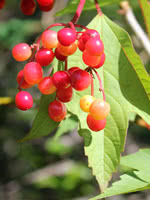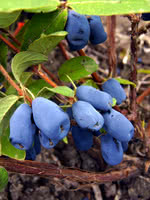Mon-Fri 9am - 5pm Mountain time
Highbush Cranberry vs Tundra Haskap (Honeyberry)
Viburnum opulus var. americanum (trilobum)
Lonicera caerulea Tundra
Highbush Cranberry produces attractive white flowers in late June and bears edible fruit that matures to a bright red colour in the late summer.
This shrub, native to much of Canada, is fast growing, and its fruit can be eaten raw or cooked into a sauce.
Tundra Haskap is sweet/tangy with a great flavour. The flavour of Haskaps is generally described as a cross between a blueberry and a raspberry. Tundra Haskaps are well suited to fresh eating, freezing, baking, and preserves. They have the firmest berries, which makes them well-suited for commercial production
For optimal fruit production, cross-pollination is required. Haskaps need to be planted with a compatible variety. Compatibility is influenced by both bloom time and genetics.
Tundra Haskap is an early-pollinating variety and pairs well with Aurora and Honey Bee.
Highbush Cranberry Quick Facts
Tundra Haskap (Honeyberry) Quick Facts
In row spacing: 0.6 m (2.0 ft)

